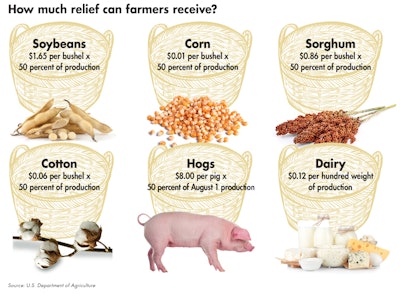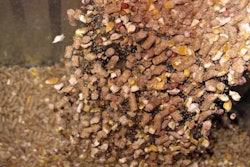
Editor’s note: This is the fourth in a series on tariffs and the trade dispute between U.S. and China that began in early 2018. Part I: US-China trade war: How did it all start?, Part II: How US-China trade dispute has affected soybean industry and Part III: Trade disputes hurt US meat industries.
The U.S. Department of Agriculture (USDA) in July said it would provide $12 billion in aid to farmers who have been hurt by retaliatory tariffs from China and other countries.
While some industry associations applauded the move, many farmers have said they don’t want the aid or that it won’t provide enough relief. Many lawmakers also opposed the move.
U.S. Secretary of Agriculture Sonny Perdue pushed the aid package as “a short-term solution that will give President Trump time to work on a long-term trade policy,” but later said, “obviously, this is not going to make farmers whole.”
The aid package targets soybean, corn, wheat, dairy and pork producers, among others. The USDA said it will use the following programs to assist farmers:
- The Market Facilitation Program, authorized under The Commodity Credit Corporation (CCC) Charter Act and administered by Farm Service Agency (FSA), will provide payments incrementally to producers of soybeans, sorghum, corn, wheat, cotton, dairy and hogs. This support will help farmers manage disrupted markets, deal with surplus commodities, and expand and develop new markets at home and abroad.
- A Food Purchase and Distribution Program through the Agricultural Marketing Service to purchase unexpected surplus of affected commodities such as fruit, nuts, rice, legumes, beef, pork and milk for distribution to food banks and other nutrition programs.
- A Trade Promotion Program administered by the Foreign Agriculture Service (FAS) in conjunction with the private sector to assist in developing new export markets for our farm products.
How much relief can famers receive?
Soybean farmers can receive $1.65 per bushel for lost sales, but corn farmers will only receive a penny per bushel. The subsidies will only cover half of this fall’s harvest. While corn is the largest U.S. harvest and export crop, soybeans have been hurt the most by the trade war between China and the U.S. Since trade tensions between the U.S. and China began, soybean prices have been falling – from a 2018 high of $10.77 per bushel to a low of $8.14 per bushel.
Reuters explained the calculations like this: USDA economists “looked at how much corn China and the European Union – two export markets that the U.S. has engaged in trade fights – imported from the U.S. in 2017. They then figured that the damage from the 25 percent tariffs on corn from China and the EU totaled $192 million. The USDA then divided that figure by the 14.6 billion bushels of corn that U.S. farmers harvested in 2017, bringing the per-bushel total to one cent – but only for half of all the bushels they harvest this year.”
Sorghum farmers can receive 86 cents per bushel, wheat farmers 14 cents per bushel and cotton farmers 6 cents per bushel. All of those amounts are multiplied by 50 percent of production to amount to the total relief.
Payments for hog farmers will be $8 per pig multiplied by 50 percent of August 1 production, while dairy farmers will receive 12 cents per hundred weight of production.

Crop producers will only receive tariff relief for half of this year's crops.
Perdue has said the aid plan is only for the 2018 crop and that the government does not expect to continue to provide aid over time. However, in September, the USDA said a second round of tariff aid could be announced in December.
“The second part will be announced, if necessary, in December and may account for other factors, such as new tariff levels, regional basis effects, or other market conditions that may have mitigated some of the trade damages,” the USDA said in a white paper.
The USDA said in November that it had paid out nearly $840 million to farmers so far, with the vast majority of that amount going to soybean, wheat, corn, dairy and hog producers. The five states that have received the highest amount of aid are Illinois, Iowa, Kansas, Indiana and Minnesota. The payouts range from $1 to $38,298, with an average payment of $147.
In October, U.S. dairy producers asked the government for additional aid, saying they have lost more than $1 billion in income since May and have only received $127 million in government compensation.
How do farmers feel about the aid package?
In a joint statement, the U.S. Wheat Associates (USW) and the National Association of Wheat Growers (NAWG) said they don’t think tariffs are the answer, but they appreciate the Trump administration’s pushback on China’s unfair trade practices.
“Our concerns still lie in a lengthy trade war that will cause long-term, irreparable harm to U.S. agriculture. We urge the administration to recognize this self-inflicted damage and to end the trade war immediately as well as to work within the rules-based trading system in partnership with like-minded countries to address serious problems in the global economy,” USW and NAWG said in a statement.
Similarly, the American Soybean Association said soybean growers appreciate the help in offsetting the lost income due to trade tensions, but that it “continues to call for a longer-term strategy to alleviate mounting soybean surpluses and continued low prices, including a plan to remove the harmful tariffs.”
The American Farm Bureau Federation (AFBF) said the relief package “is substantial, but we cannot overstate the dire consequences that farmers and ranchers are facing in relation to lost export markets. … We will continue to push for a swift and sure end to the trade war and the tariffs impacting American agriculture.”
“Farmers need contracts, not compensation, so they can create stability and plan for the future. This proposed action would only be a short-term attempt at masking the long-term damage caused by tariffs,” Farmers for Free Trade said in a statement. “Unfortunately, a one-time check won’t replace the deterioration of long-term contracts and relationships. Nor will it address the many sectors of agriculture impacted – from producers, to grain bin operators, to shippers. Farmers need stable markets to plan for the future. As such, we urge the administration to take immediate action to stop the trade war and get back to opening new markets.”
“Tariffs are taxes that punish American consumers and producers,” Kentucky Republican Sen. Rand Paul tweeted in July. “If tariffs punish farmers, the answer is not welfare for farmers — the answer is remove the tariffs.”
















